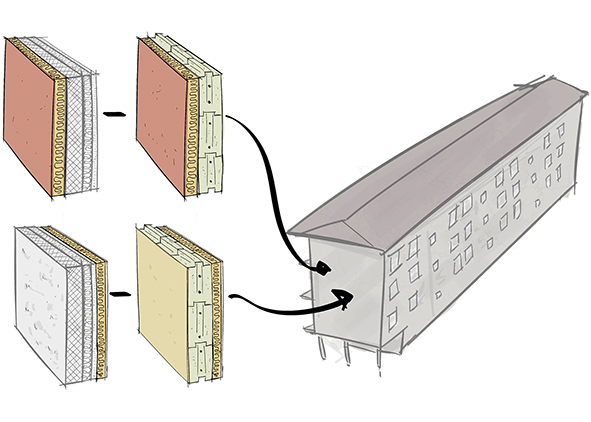Strategie di progettazione adattiva per il retrofit di edifici in risposta ai cambiamenti climatici
DOI:
https://doi.org/10.19229/2464-9309/6182019Parole chiave:
cambiamenti climatici, progettazione computazionale, progettazione ambientale, risoluzione evolutiva, approccio adattivoAbstract
L’aumento delle temperature urbane legate ai fenomeni di cambiamento climatico in atto, quale conseguenza dell’incremento delle concentrazioni di gas climalteranti nell’ambiente, le carenze prestazionali dell’edilizia in Italia e in particolare di quella edificata tra gli anni ‘70 e ‘90 del secolo scorso, l’avanzamento tecnologico delle soluzioni tecniche e della ricerca nel campo delle tecnologie digitali legate all’architettura, hanno stimolato lo sviluppo di una metodologia basata sull’uso di strumenti IT di computational desing e data exchange per la simulazione energetica degli edifici e la definizione di azioni di retrofit energetico e tecnologico ad-hoc finalizzate all’adattamento e alla mitigazione secondo scenari climatici attuali e di proiezione. Il presente contributo si focalizza sulla sperimentazione di un approccio di tipo simulativo, basato sull’utilizzo di software di tipo parametrico al fine di definire azioni di retrofit energetiche e tecnologiche attraverso un approccio metodologico replicabile per interventi di rigenerazione edilizia e urbana finalizzati alla mitigazione e all’adattamento climatico.
Downloads
##plugins.generic.articleMetricsGraph.articlePageHeading##
Riferimenti bibliografici
Ambrosini, L., Bassolino, E. and Scarpati, F. (2018), “Thermal-Perception-Driven Adaptive Design for Wellbeing in Outdoor Public Spaces: Case Studies in Naples”, in Aletta, F. and Xiao, J. (eds), Handbook of Research on Perception-Driven Approaches to Urban Assessment and Design, IGI Global, Hershey, New York, pp. 207-239. [Online] Available at: www.igi-global.com/chapter/thermal-perception-driven-adaptive-design-for-wellbeing-in-outdoor-public-spaces/198163 [Accessed 31 October 2019].
Ascione, P. and Bellomo, M. (2012), Retrofit per la residenza – Tecnologie per la riqualificazione del patrimonio edilizio in Campania, Clean Edizioni, Napoli.
Bianchi, R. (1986), Le tecniche esecutive nell’edilizia residenziale degli anni ‘80 – Dal tradizionale evoluto al cosiddetto industrializzato, Franco Angeli, Milano.
CCIAA di Napoli and ACEN / Commissione RIT (2014), Tipologie edilizie prezzario il prezzario per tipologie edilizie di Napoli e Provincia, ACEN. [Online] Available at: docplayer.it/15799306-Tipologie-edilizie-prezzario-il-prezzario-per-tipologie-edilizie-di-napoli-e-provincia.html [Accessed 31 October 2019].
Civiero, P. (2017), Tecnologie per la riqualificazione – Soluzioni e strategie per la trasformazione intelligente del comparto abitativo esistente, Maggioli Editore, Santarcangelo di Romagna.
Corsi, E. and Frano, C. (1991), Dal Terremoto al futuro – La ricostruzione a Napoli – Il titolo VIII della Legge 219/81, Electa, Napoli.
EEA (2009), Ensuring Quality of Life in Europe’s Cities and Towns – Tackling the environmental challenges driven by European and global change – EEA Report no. 5/2009, European Environment Agency, Copenaghen. [Online] Available at: eprints.uwe.ac.uk/13151/1/Quality_of_life_in_cities%5B1%5D.pdf [Accessed 31 October 2019].
Fanger, P. O. (1972), Thermal Comfort – Analysis and Application in Environmental Engineering, McGraw-Hill Book Company, New York.
IPCC – Intergovernmental Panel on Climate Change (2018), Global Warming of 1.5 °C – Summary for Policymakers, IPCC, Switzerland. [Online] Available at: report.ipcc.ch/sr15/pdf/sr15_spm_final.pdf [Accessed 31 October 2019].
IPCC – Intergovernmental Panel on Climate Change (2015), Climate Change 2014 – Synthesis Report, IPCC, Geneva. [Online] Available at: www.ipcc.ch/site/assets/uploads/2018/05/SYR_AR5_FINAL_full_wcover.pdf [Accessed 31 October 2019].
Losasso, M. (2016), “Technological and environmental aid for the knowledge of urban districts”, in D’Ambrosio, V. and Leone, M. F. (eds), Environmental design for climate adaption – 1. Innovative Models for the production of knowledge, Clean Edizioni, Napoli, pp. 92-111. [Online] Available at: www.sitda.net/downloads/biblioteca/Environmental%20Design% 20for%20Climate%20Change%20adaptation.%201.%20Innovative% 20models%20for%20the%20production%20of%20knowledge.pdf [Accessed 31 October 2019].
Muratore, G., Capuano, A., Garofalo, F. and Pellegrini, E. (1988), Guida all’architettura moderna: Italia – Gli ultimi trent’anni, Nicola Zanichelli Editore, Bologna.
Peng, C. and Elwan S. (2014), “An outdoor-indoor coupled simulation framework for Climate Change-conscious Urban Neighbourhood Design”, in Simulation, vol. 90, issue 8, pp. 874-891. [Online] Available at: doi.org/10.1177/0037549714526293 [Accessed 31 October 2019].
Tedeschi, A. (2014), Algorithms-aided design – Parametric strategies using Grasshopper®, La Penseur Publisher, Napoli.
Troup, L. and Fannon, D. (2016), “Morphing climate data to simulate building energy consumption”, in Proceedings of SimBuild 2016 – Building Performance Modelling Conference, Salt Lake City, August 8-12 2016, ASHRAE and IBPSA-USA. [Online] Available at: ibpsa-usa.org/index.php/ibpusa/article/view/390/376 [Accessed 31 October 2019].
Tucci, F. (2018), Costruire e Abitare Green – Approcci, Strategie, Sperimentazioni per una Progettazione Tecnologica Ambientale | Green Building and Dwelling – Approaches, Strategies, Experimentation for an Environmental Technological Design, Altralinea Edizioni, Firenze.
UNI (2006), UNI EN ISO 7730:2006 – Ergonomia degli ambienti termici – Determinazione analitica e interpretazione del benessere termico mediante il calcolo degli indici PMV e PPD e dei criteri di benessere termico locale, UNI Ente Italiano di Normazione.
UNI (1997), UNI-EN-ISO 7730:1997 – Ambienti termici moderati – Determinazione degli indici PMV e PPD e specifica delle condizioni di benessere termico, UNI Ente Italiano di Normazione.
UNI (1981), UNI 8290-1:1981 + A122:1983 – Edilizia residenziale – Sistema tecnologico – Classificazione e terminologia, UNI Ente Italiano di Normazione.

##submission.downloads##
Pubblicato
Come citare
Fascicolo
Sezione
Licenza
AGATHÓN è pubblicata sotto la licenza Creative Commons Attribution License 4.0 (CC-BY).
License scheme | Legal code
Questa licenza consente a chiunque di:
Condividere: riprodurre, distribuire, comunicare al pubblico, esporre in pubblico, rappresentare, eseguire e recitare questo materiale con qualsiasi mezzo e formato.
Modificare: remixare, trasformare il materiale e basarti su di esso per le tue opere per qualsiasi fine, anche commerciale.
Alle seguenti condizioni
Attribuzione: si deve riconoscere una menzione di paternità adeguata, fornire un link alla licenza e indicare se sono state effettuate delle modifiche; si può fare ciò in qualsiasi maniera ragionevole possibile, ma non con modalità tali da suggerire che il licenziante avalli l'utilizzatore o l'utilizzo del suo materiale.
Divieto di restrizioni aggiuntive: non si possono applicare termini legali o misure tecnologiche che impongano ad altri soggetti dei vincoli giuridici su quanto la licenza consente di fare.
Note
Non si è tenuti a rispettare i termini della licenza per quelle componenti del materiale che siano in pubblico dominio o nei casi in cui il nuovo utilizzo sia consentito da una eccezione o limitazione prevista dalla legge.
Non sono fornite garanzie. La licenza può non conferire tutte le autorizzazioni necessarie per l'utilizzo che ci si prefigge. Ad esempio, diritti di terzi come i diritti all'immagine, alla riservatezza e i diritti morali potrebbero restringere gli usi del materiale.


















































































